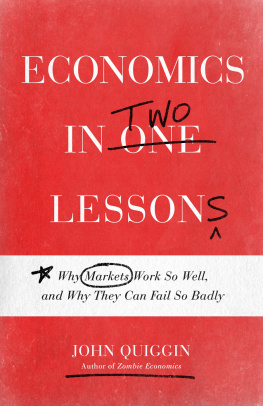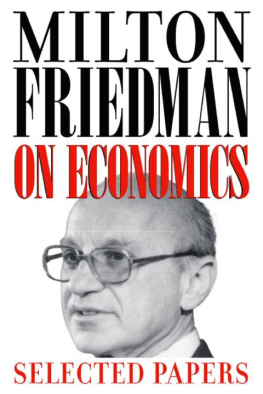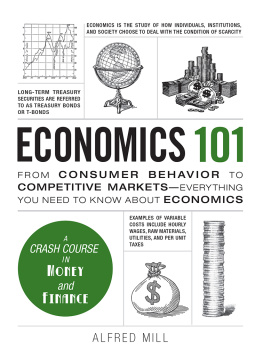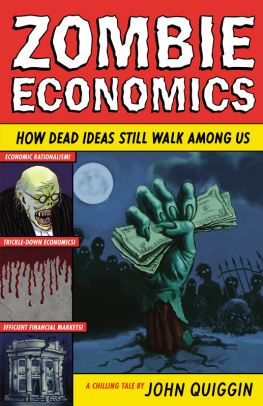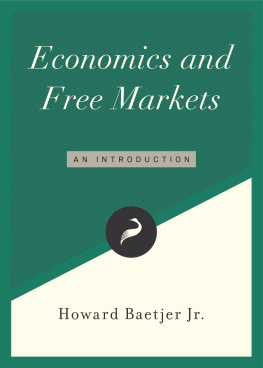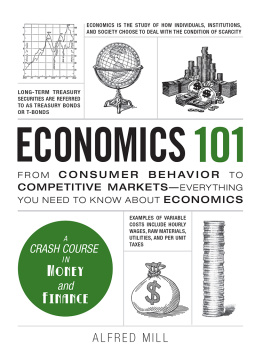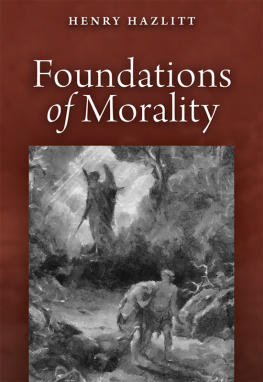
ECONOMICS
IN TWO
LESSONS
ECONOMICS
IN TWO
LESSONS
Why Markets Work So Well,
and Why They Can Fail So Badly
JOHN QUIGGIN
P RINCETON U NIVERSITY P RESS
Princeton and Oxford
Copyright 2019 by Princeton University Press
Published by Princeton University Press
41 William Street, Princeton, New Jersey 08540
6 Oxford Street, Woodstock, Oxfordshire OX20 1TR
press.princeton.edu
All Rights Reserved
Library of Congress Control Number 2018962708
First paperback printing, 2021
Paperback ISBN 978-0-691-21742-0
Cloth ISBN 978-0-691-15494-7
British Library Cataloging-in-Publication Data is available
Editorial: Sarah Caro, Hannah Paul, and Charlie Allen
Production Editorial: Jill Harris
Text Design: Pam Schnitter
Cover Design: Faceout Studio, Lindy Martin
CONTENTS

ACKNOWLEDGMENTS

The idea for this book was suggested to me back in 2011 by Seth Ditchik, my publisher at Princeton University Press, encouraged by then PUP director Peter Dougherty. Like many books, this was a long time in the writing, so long that both Seth and Peter had moved on by the time I finally had my ideas straight. Sarah Caro, who picked up the project in 2016, gave me the encouragement and prodding I needed to turn my scrappy draft into a final manuscript. I thank Seth, Peter, and Sarah for making this book happen. I am also grateful to the PUP production and marketing teams, including Bob Bettendorf, Jill Harris, Dimitri Karetnikov, Hannah Paul, Stephanie Rojas, Julie Shawvan, and Karen Verde, for their work in turning my manuscript into a real book.
I thank Roger Backhouse and another anonymous reader for PUP for their enthusiastic reaction to the book and useful suggestions for improvements. I also received valuable comments and positive feedback from academic colleagues, including Max Corden, Simon Grant, Jacob Hacker, Raja Junankar, and Flavio Menezes.
In addition to these traditional sources of feedback, I posted excerpts from the book on my blog, johnquiggin.com, and on the academic group blog, crookedtimber.org. I got so many useful responses in different media, some under pseudonyms, that I am sure to miss some. Undeterred by this, I will thank Anarcho, Anarcissie, Rob Banks, Stephen Bartos, Jim Birch, Graeme Bird, Mark Brady, ccc, CDT, Cervantes, Harry Clarke, Paul Davis, DCA, Tim Dymond, Kenny Easwaran, Geoff Edwards, Equalitus, Mike Furlan, Christian Haesemeyer, Mike Haines, Nicholas Haines, Nigel Harden, Sebastian Holsclaw, Hubert Horan, Hugo, Ikonoclast, J-D, Valerie Kay, Keshav, Ian Kirkegaard, LFC, Peter Ludemann, Greg McKenzie, Robert Merkel, Zoe Mithen, Nastywoman, Mark Nelson, Newtownian, Peter T, Philip, Greg Pius, Plasmaatron, Quentin Reynolds, Richie Rich, David Richardson, G. Branden Robinson, Sandwichman, Scott P., Simon, Matthew Smedberg, Smith, stostosto, Tabasco, Robert Vienneau, Bruce Wilder, and James Wimberley, with apologies to those Ive inevitably left out.
Special thanks go to three readers. My long-standing colleague David Adamson provided comments on all the chapters. Mike Huben read and commented in detail on all the chapters and also pointed me to useful links on his Critiques of Libertarianism site, http://critiques.us. Most of all, my beloved wife and colleague, Nancy Wallace, brought both her training as an editor and her skills as a critical reader to bear on the book, catching lots of errors and never letting me get away with a sloppy argument. Without her love and support, I could never have finished this book.
ECONOMICS
IN TWO
LESSONS
INTRODUCTION

Moral: To understand economics you need to know not only fundamentals but also its nuances. Darwin is in the nuances. When someone preaches Economics in One Lesson, I advise: Go back for the second lesson.
Paul Samuelson, An Enjoyable Life Puzzling Over Modern Finance Theory, Annual Review of Financial Economics, Vol. 1, p. 30
As the name implies, this book is, or at least began as, a response to Henry Hazlitts Economics in One Lesson, a defense of free-market economics first published in 1946. But why respond to a seventy-year-old book when new books on economics are published every day? Why two lessons instead of one? And where does opportunity cost fit into all of this?
The first question was one that naturally occurred to me when Seth Ditchik, my publisher at Princeton University Press, suggested this project. It turns out that Economics in One Lesson has been in print continuously since its first publication and has now sold more than a million copies. Hazlitts admirers have embraced the message that all economic problems have a simple answer, and one that matches their own preconceptions. Adapting Hazlitts title, this simple answer may be described as One Lesson economics.
Broadly speaking, Hazlitts simple answer is leave markets alone, and all will be well. This may be summed up, in the pithy expression of eighteenth-century French writer and free trade advocate, Ren de Voyer, Marquis dArgenson, as laissez-faire (let [business] do it).
Hazlitt, as he makes clear, was simply reworking the classic defense of free markets by the French writer Frdric Bastiat, whose 1850 pamphlets The Law and What Is Seen and What Is Unseen form the basis of much of Economics in One Lesson. However, Hazlitt extends Bastiat by including a critique of the Keynesian economic model, which was developed in response to the Great Depression of the 1930s.
Both where he was right and where he was wrong, Hazlitts One Lesson is relevant today, and has not been improved on by todays advocates of the free market, who may fairly be referred to as One Lesson economists. Indeed, precisely because he was writing at a time when support for One Lesson economics was at a particularly low ebb, Hazlitt gave a simpler and sharper presentation of the case than many of his successors.
Hazlitt presented One Lesson economics in clear and simple terms that have not been sharpened by any subsequent writer. And, despite impressive advances in mathematical sophistication and the advent of powerful computer models, the basic questions in economics have not changed much since Hazlitt wrote, nor have the key debates been resolved. So, he may be read just if he were writing today.
Hazlitt worked in the tradition of microeconomics, that is, the study of the way prices work in particular markets. The central question, which will be the main focus of this book, is whether the prices of goods and services reflect, and determine, all the costs involved for a society in providing those goods and services, summed up in the concept of opportunity cost.
The opportunity cost of anything of value is what you must give up so that you can have it.
Opportunity cost is critical both in individual decisions and for society as a whole.
Reading Hazlitt, the centrality of opportunity cost isnt immediately evident. Hazlitt states his One Lesson as:
The art of economics consists in looking not merely at the immediate but at the longer effects of any act or policy; it consists in tracing the consequences of that policy not merely for one group but for all groups.
This isnt particularly helpful: it seems to say only that economists should do a thorough job. But, on reading Economics in One Lesson it becomes clear that Hazlitt, as an anti-government activist, wants to make a much stronger claim. When economics is done properly, Hazlitt argues, the answer is always to leave the market alone. So, the One Lesson may be restated as:
Next page
